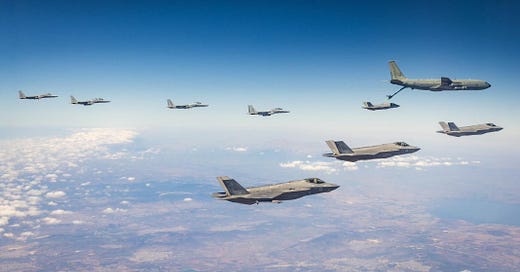The Israeli Air Force (IAF) conducted an extensive aerial refueling exercise simulating long-range flight operations deep behind enemy lines.
The drill, held on Thursday, involved key aircraft from Israel’s fleet, including the “Adir” (F-35i), “Baz” (F-15), and “Ram” (Boeing 707) refueling aircraft.
This exercise, conducted within Israeli airspace, was designed to simulate conditions that the IAF might encounter during a mission requiring extended flight times far from Israeli borders. The ability to perform aerial refueling in short timeframes is critical for maintaining a sustained combat presence in distant operational theaters.
“Aerial refueling is an operational capability required by the combat force, enabling it to remain airborne for long periods of time,” a spokesperson for the Israeli Air Force stated, emphasizing the significance of the exercise.The drill comes at a time of heightened tensions between Israel and Iran, sending a clear message about Israel’s preparedness to conduct long-range operations if necessary.
The aircraft involved in the exercise represent the cutting edge of Israel’s aerial capabilities. The F-35i, known as “Adir,” is a stealth fighter with advanced avionics and weapons systems, designed for both air superiority and strike missions. The F-15 “Baz,” a long-standing workhorse of the IAF, provides a robust platform for air-to-air combat and precision strikes. The “Ram” Boeing 707 aircraft plays a crucial role in extending the operational range of these fighters through in-flight refueling.
Israeli Air Force has operated F-15s since 1977. The IAF operates 38 F-15A, 6 F-15B, 16 F-15C and 11 F-15D in service as of 2022.
The Israeli Air Force (IAF) declared the F-35 operationally capable on 6 December 2017. According to Kuwaiti newspaper Al Jarida, in July 2018, a test mission of at least three IAF F-35s flew to Iran's capital Tehran and back to Tel Aviv. While publicly unconfirmed, regional leaders acted on the report; Iran's supreme leader Ali Khamenei reportedly fired the air force chief and commander of Iran's Revolutionary Guard Corps over the mission.
On 22 May 2018, IAF chief Amikam Norkin said that the service had employed their F-35Is in two attacks on two battle fronts, marking the first combat operation of an F-35 by any country. Norkin said it had been flown "all over the Middle East", and showed photos of an F-35I flying over Beirut in daylight. In July 2019, Israel expanded its strikes against Iranian missile shipments; IAF F-35Is allegedly struck Iranian targets in Iraq twice.[313]
In November 2020, the IAF announced the delivery of a unique F-35I testbed aircraft among a delivery of four aircraft received in August, to be used to test and integrate Israeli-produced weapons and electronic systems on F-35s received later. This is the only example of a testbed F-35 delivered to a non-US air force.
On 11 May 2021, eight IAF F-35Is took part in an attack on 150 targets in Hamas' rocket array, including 50–70 launch pits in the northern Gaza Strip, as part of Operation Guardian of the Walls.
On 6 March 2022, the IDF stated that on 15 March 2021, F-35Is shot down two Iranian drones carrying weapons to the Gaza Strip. This was the first operational shoot down and interception carried out by the F-35. They were also used in the Israel–Hamas war.
On 2 November 2023, the IDF posted on social media that they used an F-35I to shoot down a Houthi cruise missile over the Red Sea that was fired from Yemen during the Israel-Hamas War.




This would be an excellent opportunity to test the US fighter/bomber aircraft against the latest in Russian missile defense gear, with neither side getting involved, although you know some Russian technicians are manning the sophisticated missile defense, at the Iranian sites.
Israel just sent up the ballon, Russia has to answer.
I'll bet they say no.
The F35 was designed to be stealth so all munitions (rockets, bombs) had to be inside the plane. Thus the plane is bulbous and needed huge engines to make it fast. There have been many problems with the tremendous heat generated by the engines and I understand the heat signature strongly hurts its stealth.
Russia get the military hardware that keeps Russia safe. America get the weapons systems that make the military industrial complex very rich. Which western fighter jet was embarrassed by the Russian fighter jet at the European air show a few years ago?